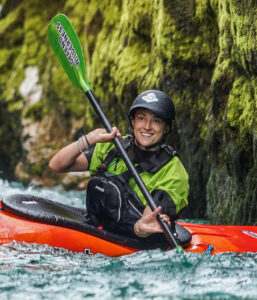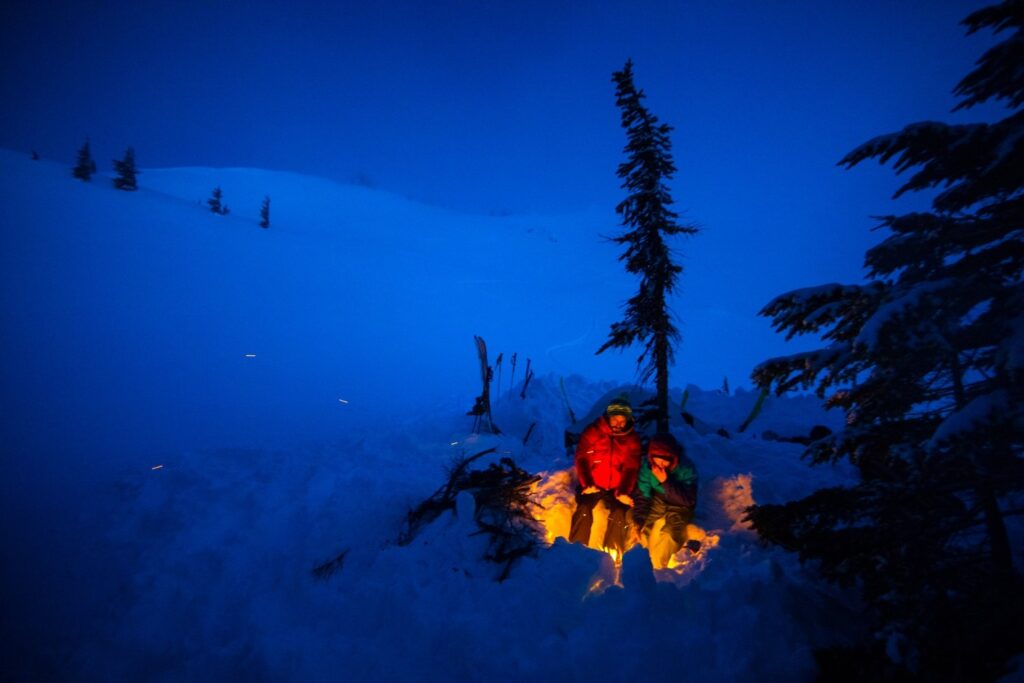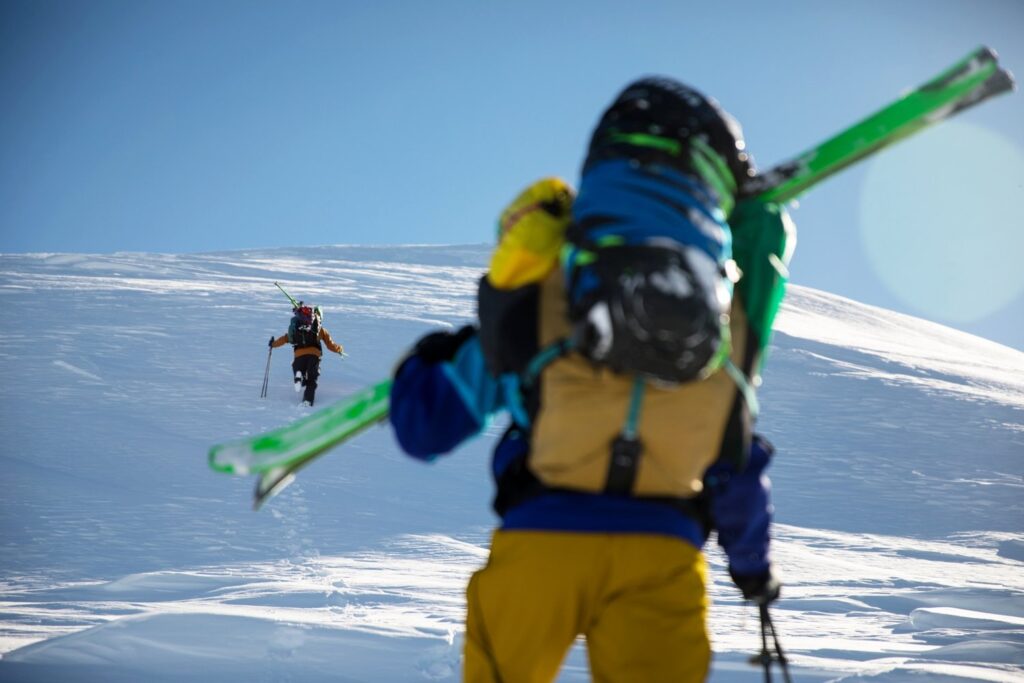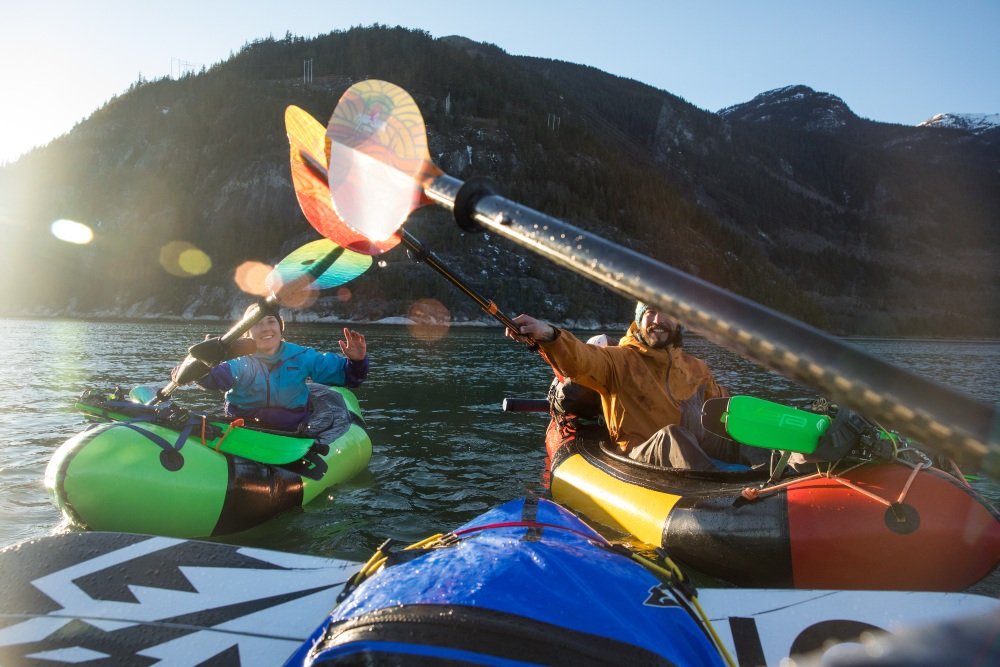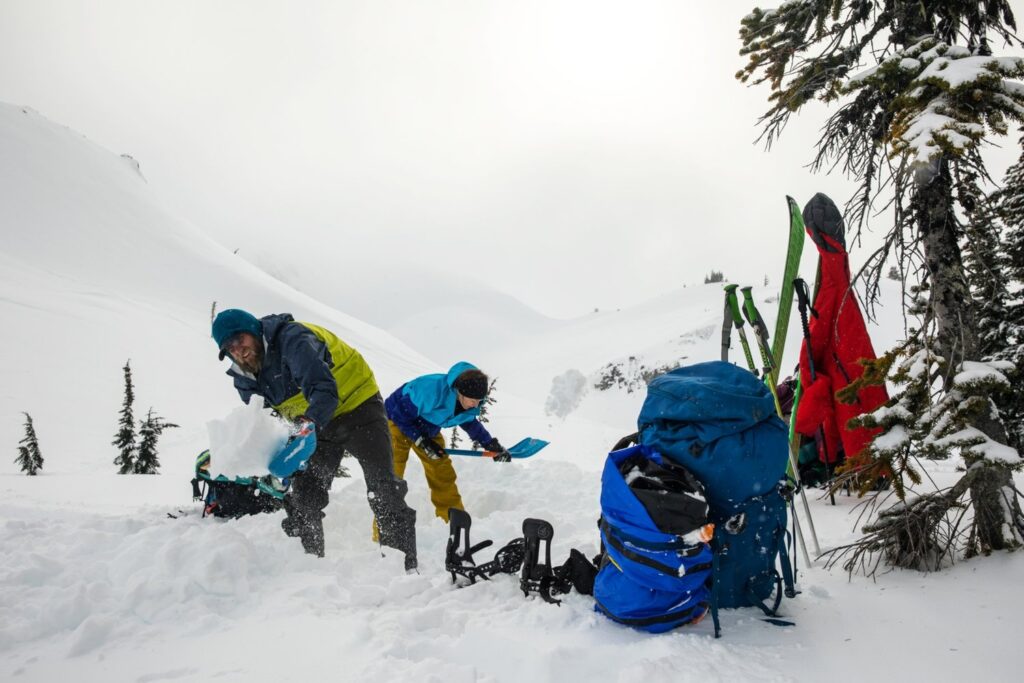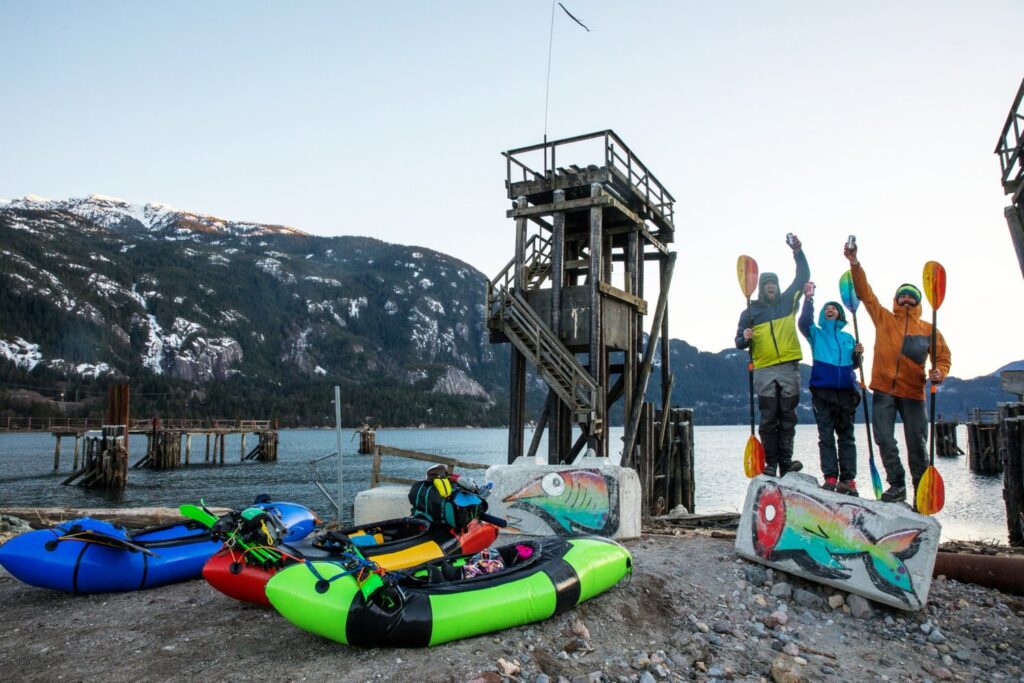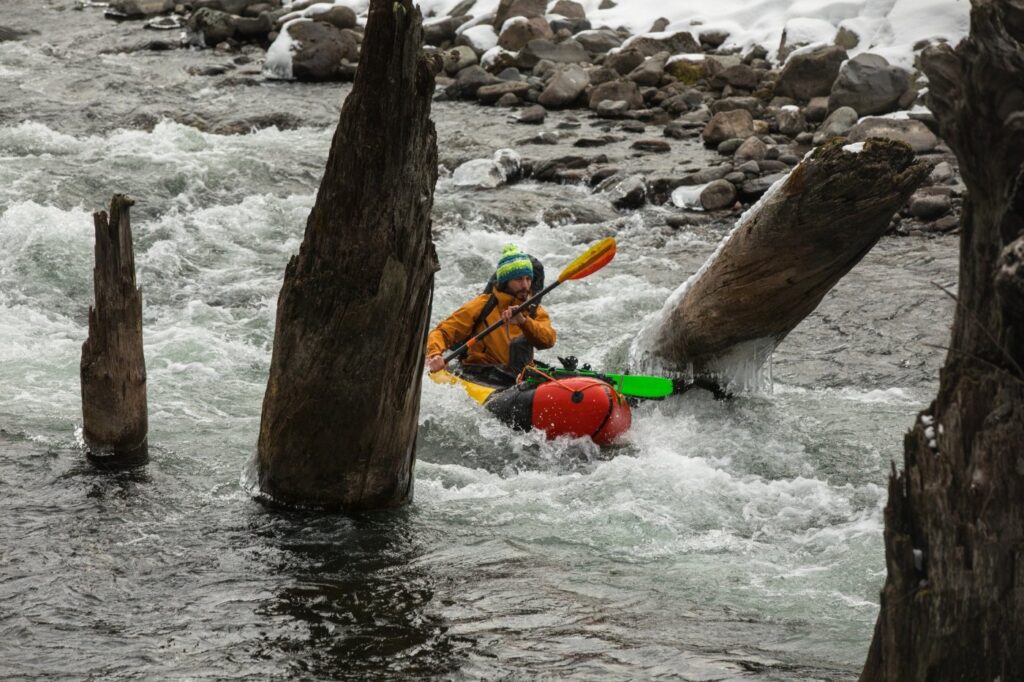Home Story Into the Crystal Current
Into the Crystal Current
Feature type Story
Read time 12 min read
Published Oct 20, 2021
Author Carmen Kuntz
Photographer Andrew Burr
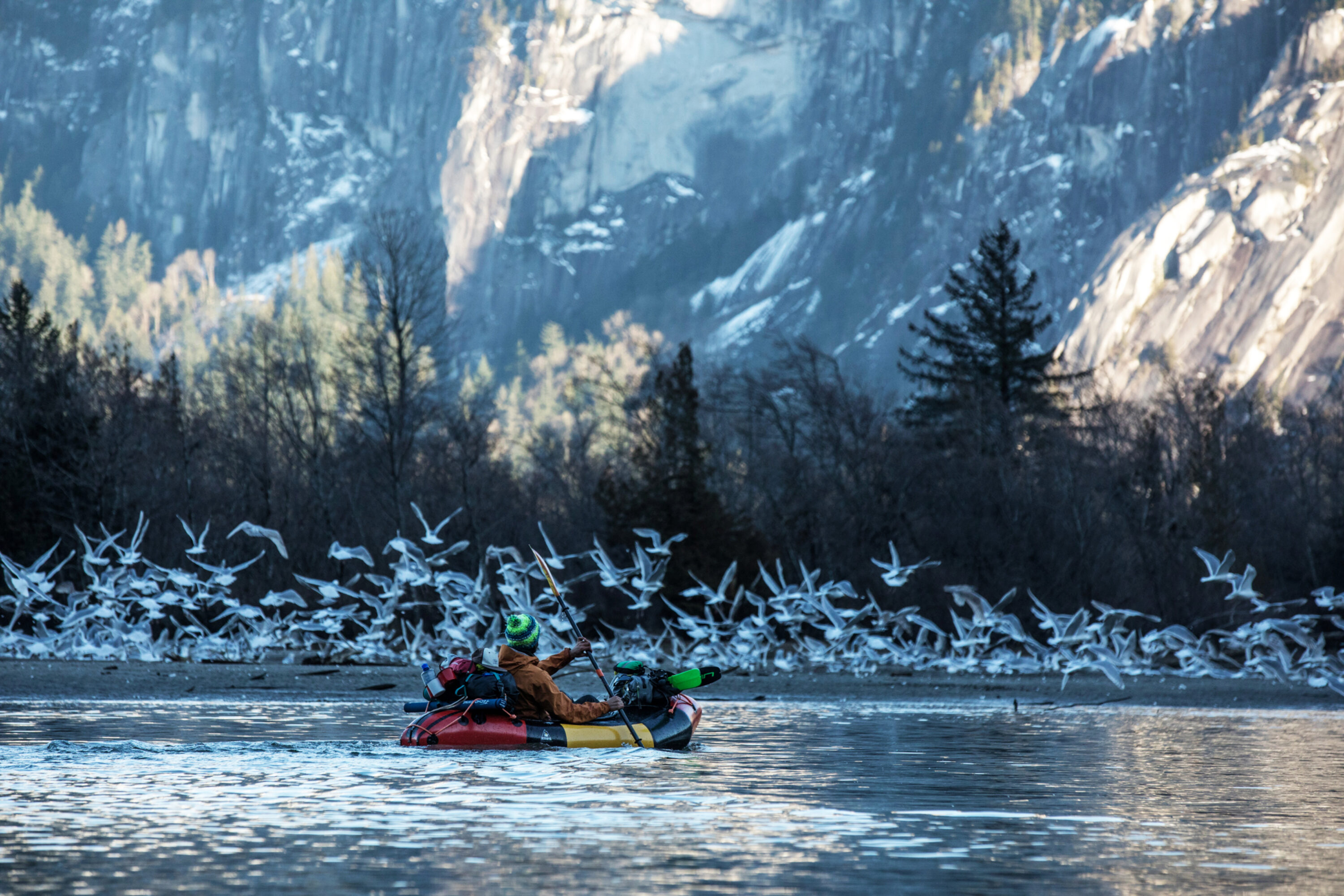
Following seals and seagulls from the freshwater of the Squamish River into the salt water of the Pacific Ocean with the granite dome of the Stawamus Chief reflecting the last of the day’s sunlight.
An Unusual Idea
Frozen fingers and stiff waterproof zips are never the best combination. But perhaps it is just this kind of combination that makes an adventure in both whitewater and snow so different.
It’s 7am on an unseasonally cold Tuesday in March. Just minutes ago, a friend dropped us off on the side of Canada’s iconic Sea-to-Sky highway, which connects the Pacific Ocean of Vancouver to the Coast Mountains of Whistler. With hoods up and gloves on we trudged through hip deep snow to the edge of the Cheakamus River. The dexterity of my digits was already limited when I started stuffing my sleeping bag, sleeping mat, boots and clothes into the tubes of my packraft.
After fumbling the packraft zips shut with hands that felt like clubs, I inflated my boat, creating a whitewater vessel that doubled as a kind of giant drybag. This is where things got unusual; I grabbed by skis and poles, and lashed them to the outside of my inflatable. And then I pushed off into the current, laughing at the strange view of a pair of ski tips crashing through whitewater.
The plan was simple enough. We would combine travel across water in both its liquid and solid states by paddling two rivers, on either side of the same mountain. In between, we would draw some lines in the snow with skis under us and packrafts on our backs. We would use a unique combination of skis and packrafts to get to know two rivers – and the frozen source of some of that water. Paddling the Cheakamus River was the first segment of this three-stage winter adventure, with some mellow class two whitewater leading to the base of Cloudburst Mountain. Here, we would roll up rafts, strap them to our backs and ski tour up the 1800m peak. Then, we’d ski down the other side to launch packrafts into the Squamish River and paddle the final 30 kilometres to the Pacific Ocean to complete our ski-packing, raft-skiing adventure.
Convincing my Slovenian boyfriend Rok and our photographer buddy Andrew that this trip was a good idea was easier than expected. Paddle. Ski. Paddle. Simple concept. But when Arctic outflow winds plummeted temperatures at home in Squamish, BC in early March, the dates we penciled in for the trip seemed a bit ambitious. Despite our trip’s close proximity to civilisation – we would be less than 30 kilometres as the crow flies from the mountain town of Squamish – the basics of mountain wilderness survival would apply just the same. Food, water, shelter, and warmth would be critical. Warmth, in particular, was on our minds. We knew we were going to need more than just whisky to keep us warm out there.
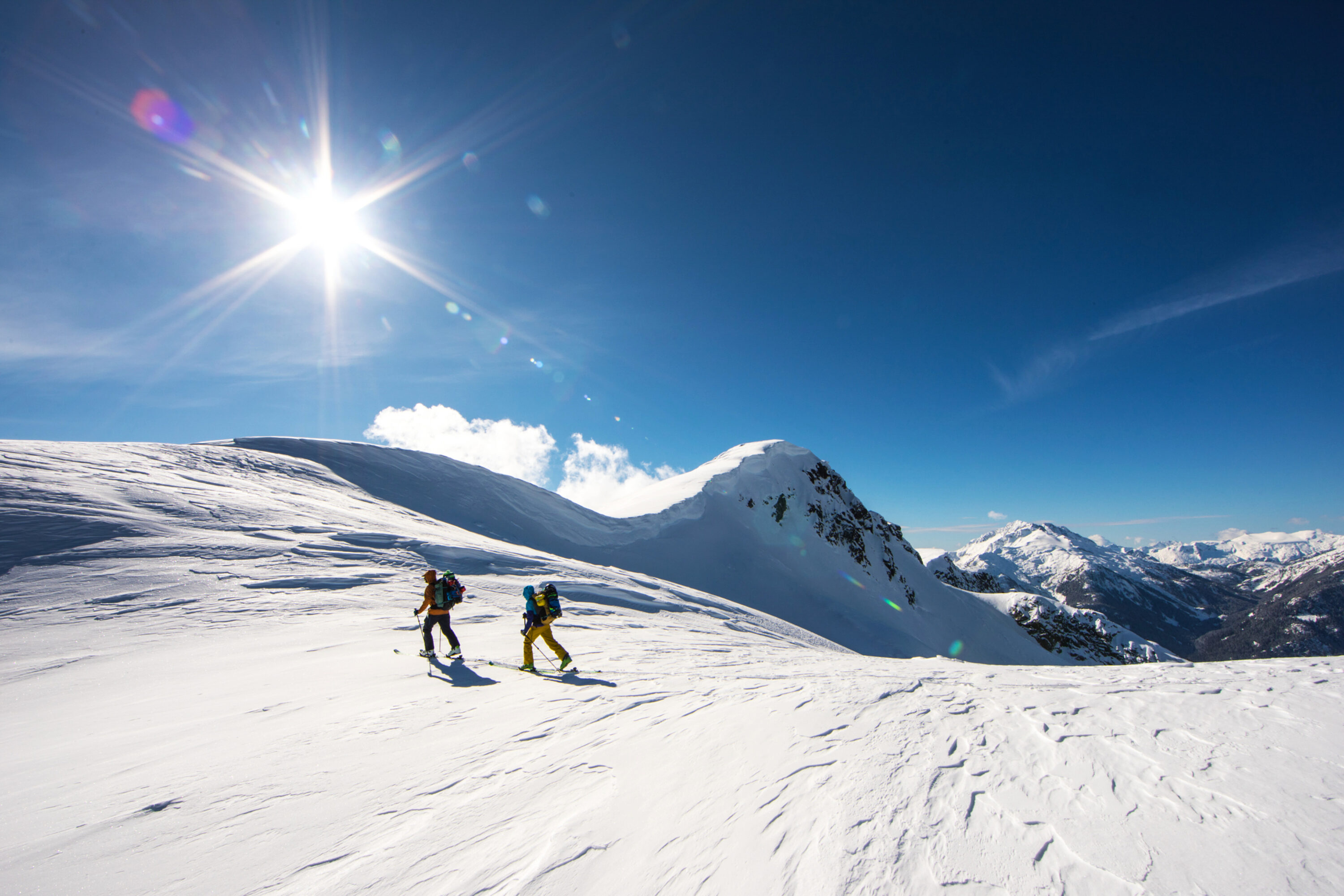
Navigating the cornice-encrusted approach to the peak of Cloudburst Mountain, the 1880 metre summit that rises above the head of Howe Sound, British Columbia.
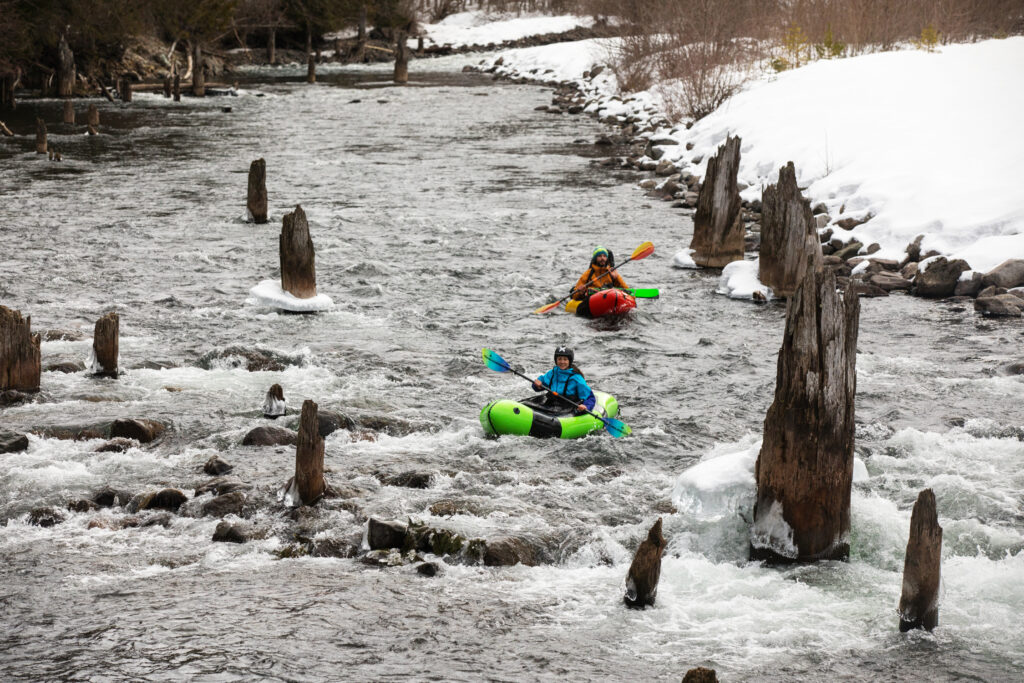
Packrafting the Cheakamus River with gear-stuffed boats.
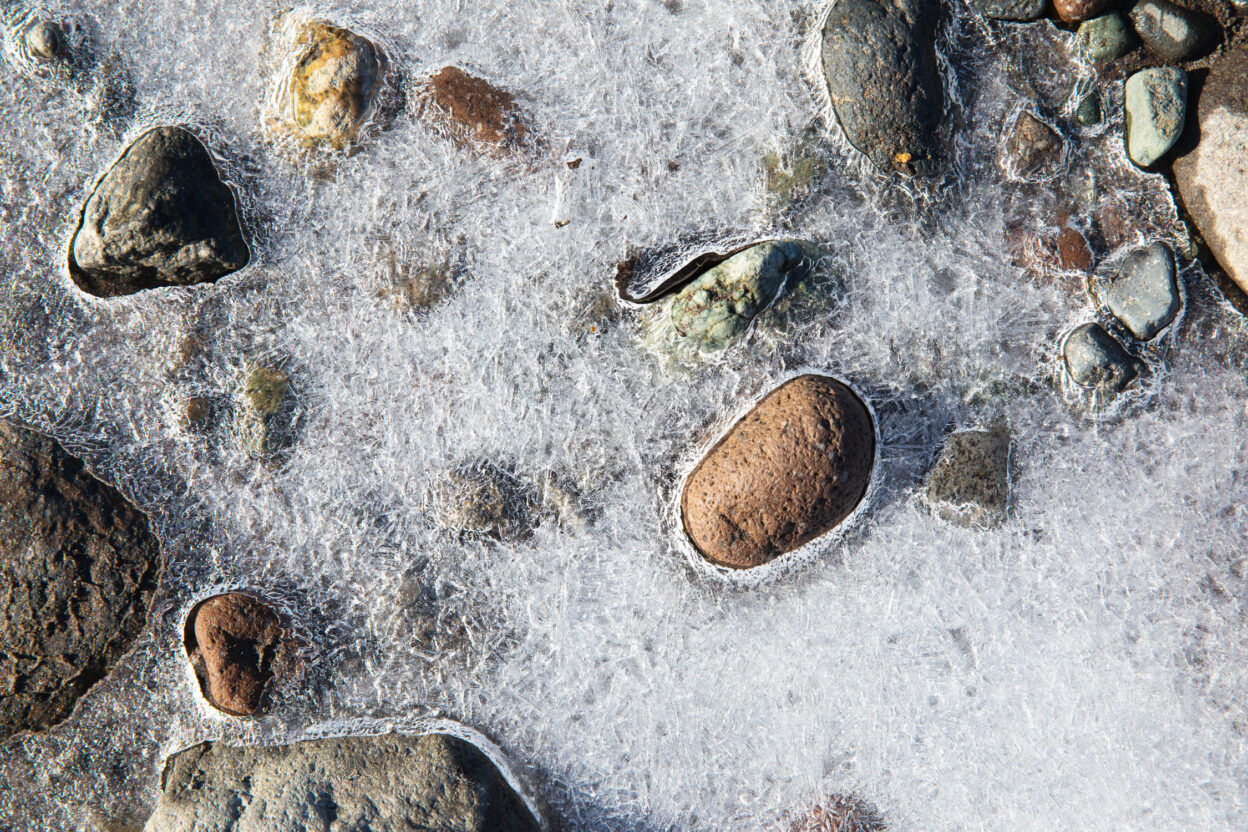
Ice encapsulates rocks on the banks of the Cheakamus River.
It was the kind of cold where a deep intake of breath causes the hairs in your nostrils to freeze together
Cheakamus River
Pivoting through rapids scattered with ice-encrusted rocks, I tried to keep my hands dry as we passed psychedelic mushroom-like ice formations. We weaved around massive frozen cedar logs, huge relics from the British Columbia’s past and present logging industry. I caught myself picturing my sleeping bag inside my raft tube, literally bouncing off rocks in shallow spots, or breaking waves in rapids. I was still getting used to this inflatable raft concept.
Rok and I are whitewater kayakers. And kayakers typically don’t like carrying kayaks. Any expedition paddler will agree that carrying a boat through thick forest, across slippery rocks, or up steep riverbanks is the worst part of the sport. Packrafts, however, offer a lighter alternative. These inflatable, single-person mini rafts can’t run technical class V rapids or drop waterfalls. They are inflatable, floatable, lightweight facilitators of good times on the water. Ours were made of durable ultra-light nylon and had waterproof zips allowing the tubes to be filled with gear. They weigh less than eight pounds when deflated and can be rolled a packable bundle small enough to fit in or on a pack. Kind of perfect for exploration adventures, I thought, after I first paddled one. This trip would prove whether or not my hunch was accurate.
Navigating whitewater in the winter meant taking dry lines and triple-checking our spray decks were taught. But water found its way in, as it invariably does, and we were soon paddling with freezing puddles in our boats. Around midday, we swapped paddles for poles and attached our dripping, deflated rafts to our backpacks. We stepped out of the river sand, onto the snow and into our skis to start the long skin up Cloudburst Mountain.
Even as we were transitioning from one sport to another, calling this trip an ‘expedition’ felt like an exaggeration. Isn’t an expedition going somewhere no one has been? This trip, though, was certainly an adventure. We are conditioned to think that adventures like this require big budgets and that they must occur in very wild, far flung locations. But the three of us had our own idea of what adventure meant. We weren’t trying to go the fastest, the highest or to the extremes. We just looked at a map, gathered or borrowed gear, and got creative. The entire five-day route would occur within cell phone reception, yet with skis underfoot and packrafts strapped to our backs, we were somehow using my backyard to create a challenging adventure close to home.
Cloudburst Mountain
Cloudburst Mountain is a sprawling granite massif marking the southernmost point of the Squamish-Cheakamus divide, the two rivers which feed fresh snowmelt to the Pacific Ocean. As we skinned uphill, I contemplated the frozen and liquid water that made this trip possible. Skiing is a highly visible activity, where only intense wind, heavy snow or the warmth of the sun can erase the story of an ascent or descent. Paddling, conversely, is an almost invisible activity, where paddle strokes disappear as soon as the blade leaves the water. A few footprints in the riverside snow and sand were all we left after a morning spent paddling to the mountain’s base. Ahead of me, the stories of rapids and river ice drip off my friends’ backpacks as they toil uphill, hinting at the origins of this water in the Cheakamus River, by now some 800 metres below us.
As light dwindles, we stomp out a tent spot and inhale our dinner. Tonight, the temperature will drop to -15 degrees Celsius, and the wind will blow hard: very physical reminders that in the mountains, ‘surviving the night’ is not a cliché, it’s a reality. As we tucked into our sleeping bags, squirming and shifting to add some warmth, it was shocking to think that we were just 10 kilometres as the crow flies from the nearest road. On a map of BC, it looked more like we were camping in an extension of Squamish’s backyard than the backcountry. And yet, despite how close we were to the comforts of civilisation, the basics of mountain survival still applied up here. We went to sleep that night like bunch of nervously excited scouts squished together in a small tent, listening to snowflakes dancing lightly on the tent flysheet.
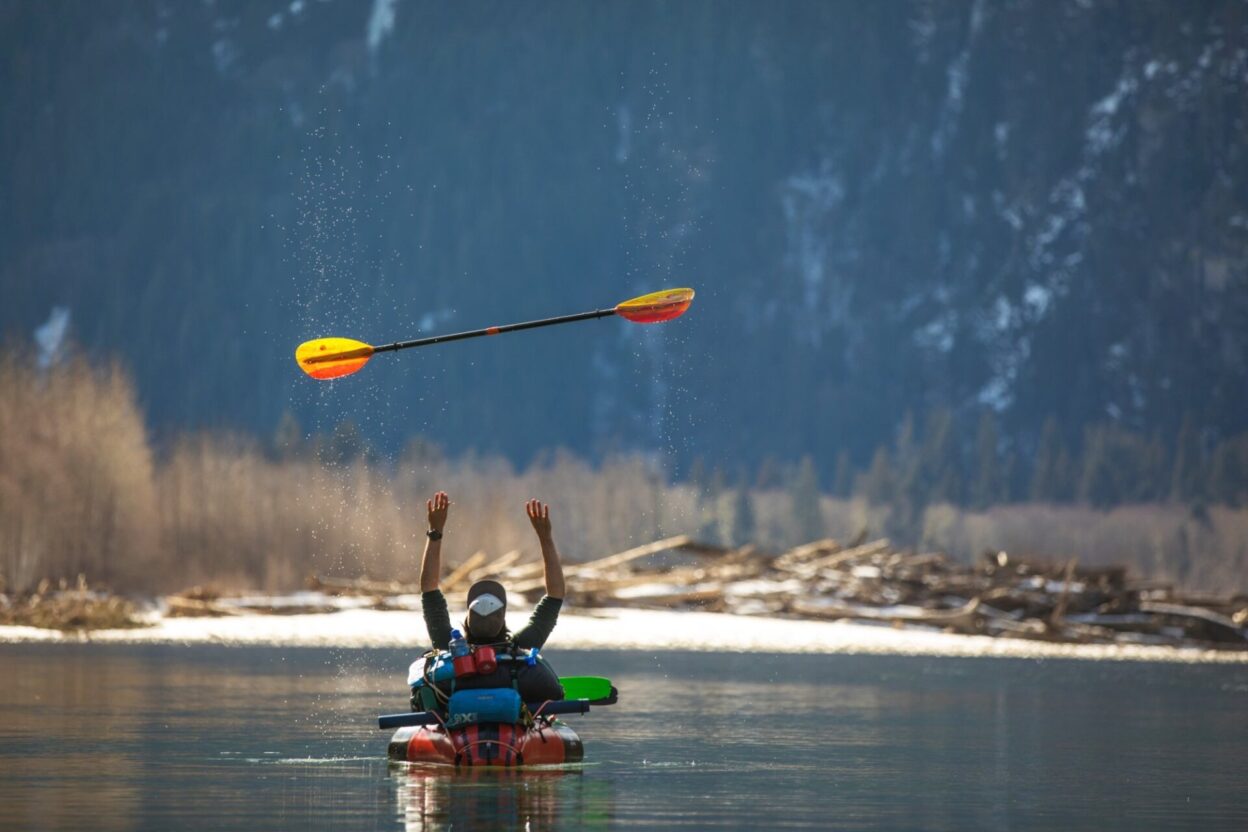
A few glorious moments of sunshine can (almost) make you forget the Arctic outflow winds that will greet you around the next corner.
Fuelled by oats and cowboy coffee, we crunched upwards the next day through glades of cedars and spruce. True to the mountain’s name, afternoon clouds rolled in and visibility became limited. At a similar pace, the realisation settled in that we wouldn’t summit and ski down today. We were forced to set camp early, and chose a spot near the tree-line in a sparse stand of gangly western hemlocks. It was bitterly cold: cold enough that fingers come out of mitts just long enough to light the stove or stir the pasta. The kind of cold where a deep intake of breath causes your nose hairs to freeze together. Add in that charming element called windchill, and you have conditions where constant movement is the only way to stay warm. Our ‘accessible’ adventure was becoming more exciting.
The sun drew us out of the tent early and a bluebird day greeted us. Navigating the cornice-crusted ridgeline in the bright sunshine, we reached the summit well before midday. Our time on the top of Cloudburst Mountain was brief, reaffirming that this trip wasn’t about summits or accomplishments. We snapped some pictures and slapped some high fives, and then tucked away from the wind to have a quick summit snack, watching the Squamish River snaking down the valley into the Pacific.
Skins came off but hoods stayed tightly secured against the whipping wind and we started the frozen descent, using gravity to follow the path of the water cycle back downhill. We experienced the sharp textures of wind slab and crust on the upper slopes, and the soggy slog of sun-cooked mashed potato snow lower down. We moved fast on the switch-backing, snow-packed logging road — popping and playing on the rollers, humps and jumps — before bare gravel marking the snow-line forced us to shoulder our skis, and to walk for a tedious five kilometres to the riverbank. Here, the reward of whitewater awaited us once again.
The Squamish River
The satisfaction of unrolling a packraft carried over a mountain erased any thoughts of retreat, as we crossed a dirt road that led to town, frequented by local fishermen in pick-ups. It was still cold. We could have called it quits and hitched a ride back to town. But the feeling of floating on the clear water of the Squamish River was glorious, and contrasted with the uphill slog of the previous days on Cloudburst Mountain. We had a few hours of sheltered paddling before the wind worked up again, and blasted frozen sand in our faces. We zipped past the riverbank, flowing closer to the Pacific, but also closer to the residential areas of Squamish itself. In spots the river ran just metres from roads and homes and Squamish First Nation communities, buffered and hidden by thick flood forest. But the wild, scattered driftwood and meandering braids of this wild river made it feel like we were on more remote waters in BC’s furthest backcountry. Small rapids, swifts, and fast-moving sections pulled us along, and we revelled in the ease of travelling by liquified snow, leaving not a trace behind our boats.
There was no need for our paper map anymore; the river knew where to go. Our navigation over the past few days had been devoid of technology; a paper map, decent backcountry navigation experience, and common sense was all we brought. For emergencies, I carried my cell phone deep in my pack. But I almost forgot it was there. It felt light and refreshing to be without screens and buttons, an increasingly unusual experience in the backcountry today.
Because we were just outside of town, our route was more of a direction than a plan, and we used large landmarks like drainages and the occasional clear-cut swath to orient ourselves. If at any point we had veered horribly off course, we would have met a creek, a rural road, or the Squamish River. We weaved and wandered at times and were not as efficient in tracking our course, but we problem-solved our way toward the summit and then the river, which just added to the adventure.
We had been optimistic that we would gain a few degrees of warmth down in the valley. But the moist river air and cold Arctic wind funnelled down from the higher slopes and taught us that expectations can be unfriendly. Sleeping on hard-frozen sand beneath our tent, we waited for the sun to coax us out in in the morning. When we emerged, the only way we could boil water without the wind blowing the stove out was by lying partially inside a massive old-growth driftwood stump. Comically, just a few hundred metres away, and out of sight on the other side of the river, people were boiling water in kettles to make their morning coffee. As we flowed closer to town, those people started appearing on the banks, walking the riverside trails with kids on bikes or dogs off-leash, enjoying the almost-spring sunshine.
They probably thought we were crazy for paddling the Squamish in such cold weather; if only they knew how far we had really travelled.
Each icy paddle stroke of our journey confirmed the philosophy that adventure should also be fun
Our pre-trip tidal chart check paid off, and on our final day we timed our transition from fresh water to saltwater with the receding tide. Compared to other parts of our trip, the last leg was one from an adventure fairy tale. The breeze diminished to a very slight tail wind. The draw of the outgoing tide pulled us through the estuary, and a group of curious seals escorted us into Howe Sound and the water of the Pacific Ocean. The sun was on the horizon as we took our last paddle strokes to finally land on the shore at Nexen Beach close to downtown Squamish, among the eerie wooden skeletons of the old shipyard.
From the windswept alpine to pebbled river beds, this simple idea of combining two sports and water in multiple states proved to be quite the combination. By the time we pulled our boats on shore, we could compare how water behaves when it crystallises overnight on the steel edge of ski, or when it floats through the air after a powder turn, or how it moves over a shallow gravel bar in the river. The tracks and trails of this winter adventure were written in the snow, sand, frost and frozen water, and would disappear at different intervals. Some, like the pull of a paddle stroke in a swirling eddy, were already long gone. Others, like our skin tracks, would completely disappear only with the spring.
Over cold beer and fresh sushi, we shared stories of our adventure with friends, and somehow the cold nights started to seem less cold. The struggle of skinning and skiing with cumbersome packs went from painful to funny. After all, isn’t adventure primarily about fun – about exploring and experiencing the unknown in a state of play? Each icy paddle stroke and every waterlogged step of this adventure demonstrated that philosophy. We unintentionally proved you don’t need expensive plane tickets, weeks of planning, or fancy navigational technology to enjoy the wilderness. To appreciate the experience of the backcountry, you just need a crazy idea and some willing friends to join you. As a Canadian, I know I’m spoiled for close-to-home adventures. But this trip opened my mind for many new trips I’d never previously considered. It also highlighted how a multi-disciplinary approach can open up new opportunities for adventures closer to home.
Over another round of beers, cracked with wind-chapped fingers and sipped with sun-burnt smiles, the stories kept coming; stories of hardship and accomplishment, of mischief and laughter. Some we share, some we keep inside, and some simply disappear when the snow melts and the river rises in spring.
Don’t miss a single adventure
Sign up to our free newsletter and get a weekly BASE hit to your inbox
Other posts by this author
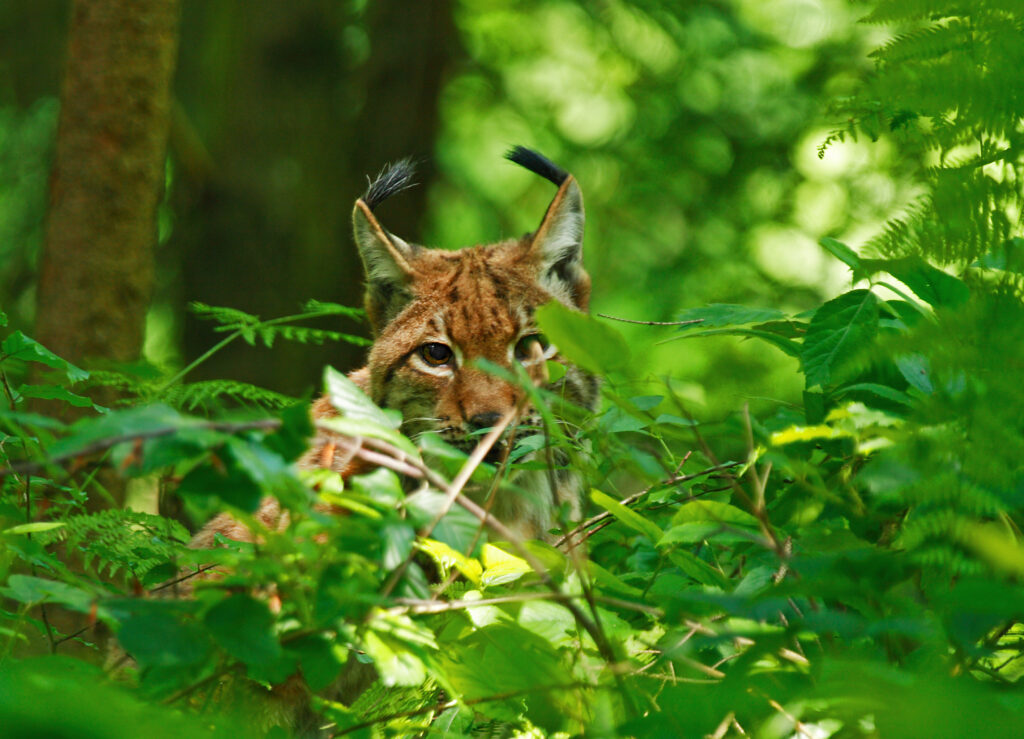
Story • Carmen Kuntz • Mar 24, 2023
The Missing Lynx: The Return Of Slovenia’s Big Cat
Hunters are the reason that lynx roam the forests of Slovenia again
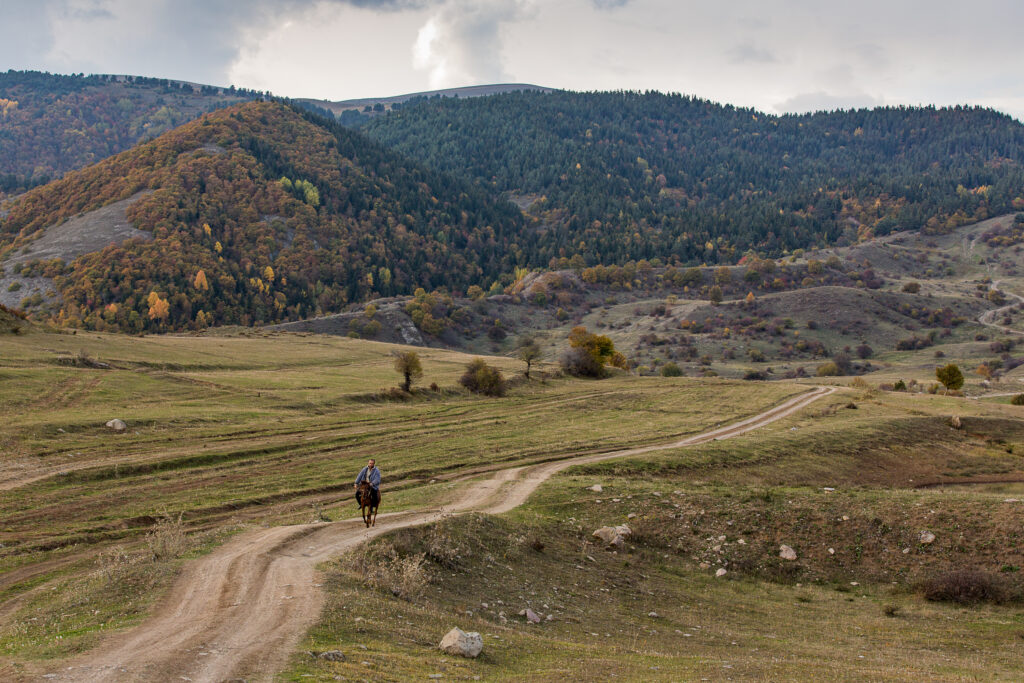
Story • Carmen Kuntz • Mar 06, 2023
How Innovative Nature Conservation Is Making a Big Difference in Armenia
The people behind the ECF project - protecting wildlife and supporting local communities in the South Caucasus
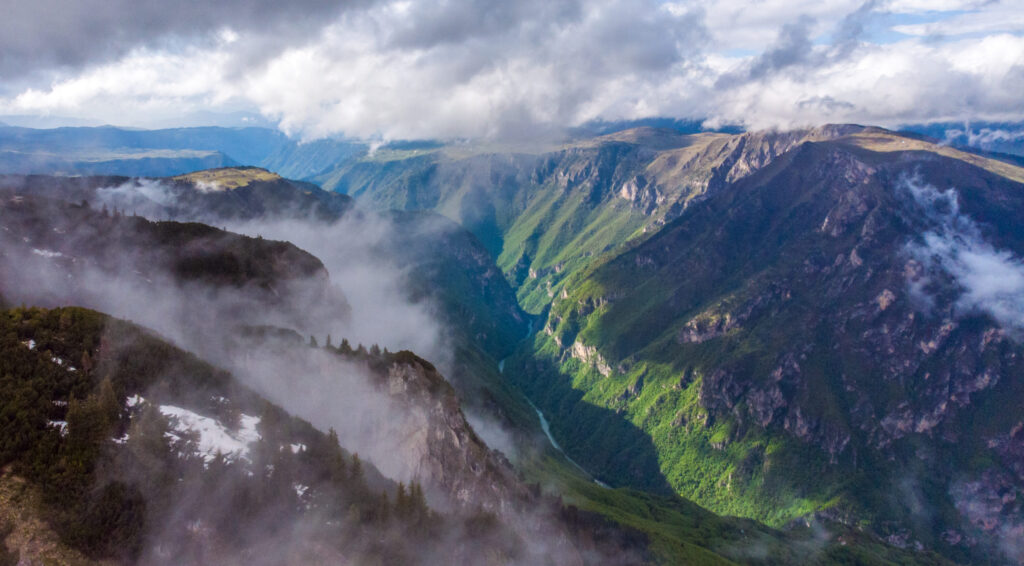
Story • Carmen Kuntz • Nov 30, 2022
Pioneers of Whitewater
The figures behind an adventure tourism movement in southeastern Europe
You might also like
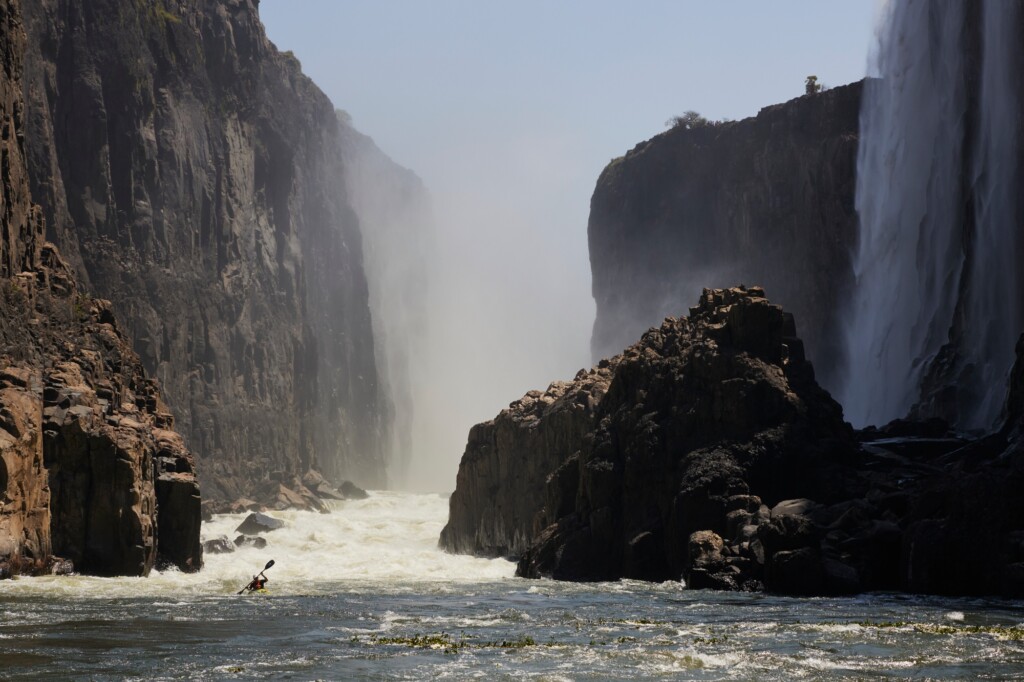
Story • Ed Smith • Jul 26, 2023
Victoria Falls: The Smoke That Thunders
Exploring a personal relationship with the Zambezi and its uncertain future by kayak
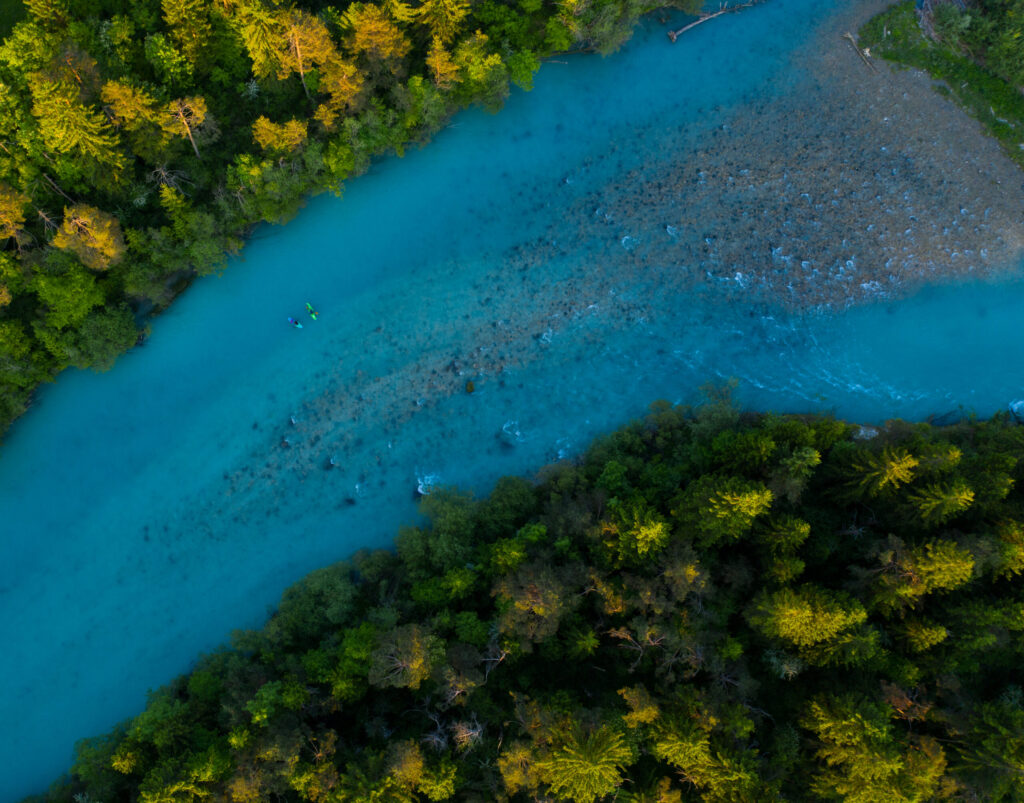
Story • Carmen Kuntz • Feb 18, 2022
One With The River
Whitewater kayaking and environmental action on Slovenia's Sava River
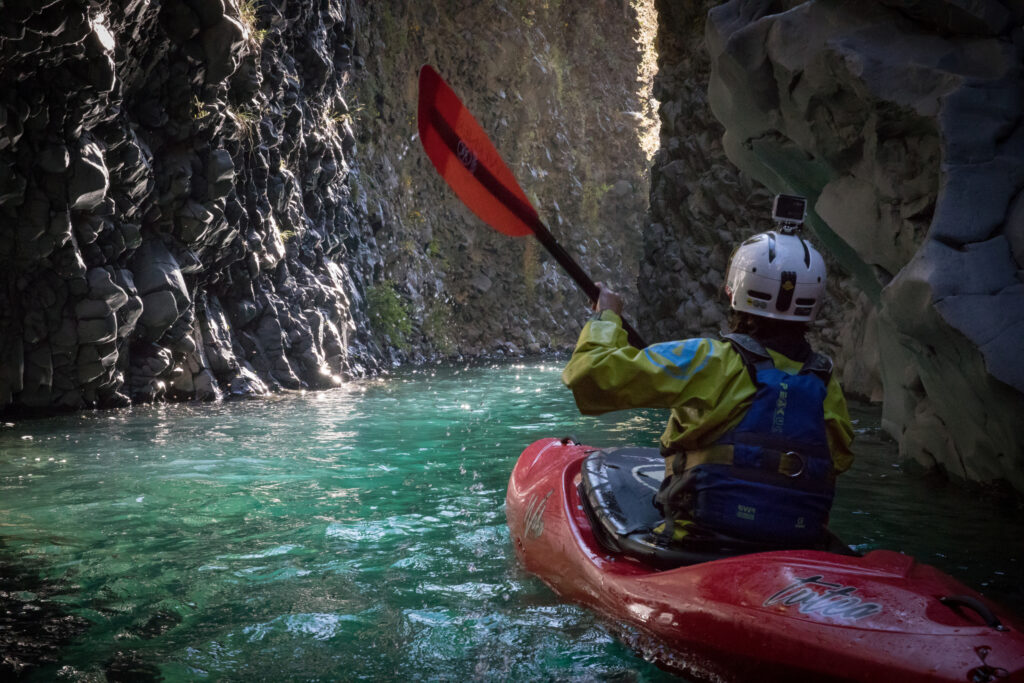
Story • Sal Montgomery • Jan 21, 2022
Pursuit of Place
Finding purpose and community on the wild rivers of Chile
